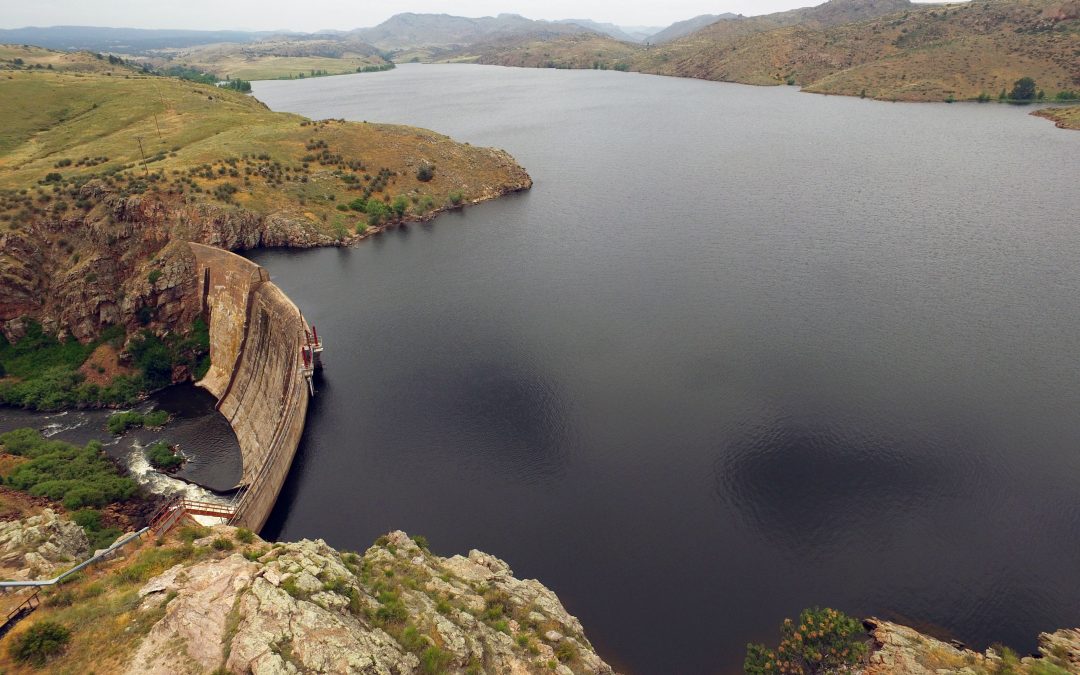“Let’s get it done…it’s been forever that we keep talking [about the Halligan Water Supply Project].”
– A recent comment on the City of Fort Collins Utilities’ Facebook page
Right now, the schedule to expand Halligan Reservoir is not driven by us, the City of Fort Collins; it’s driven by the lead permitting agency, the U.S. Army Corps of Engineers (Corps).

By raising the dam at Halligan reservoir, its storage capacity will expand by about 8,100 acre-feet.
If approved, the Halligan Water Supply Project will enlarge the existing Halligan Reservoir, which sits 25 miles northwest of Fort Collins, by approximately 8,100 acre-feet to meet the demand of future Fort Collins Utilities’ water customers and provide increased reliability for existing customers in the event of prolonged drought or other emergencies. These include infrastructure failure, wildfires or floods.
Water storage projects like Halligan involve much more than just constructing or enlarging a dam—they’re also environmental mitigation and enhancement projects.
The National Environmental Policy Act (NEPA) requires federal agencies to evaluate the environmental impacts related to the proposed project and all its alternatives. The Corps is leading this evaluation and will issue a permit for the “least environmentally damaging practicable alternative” (LEDPA), also known as the project that has the fewest negative impacts on the environment and is also practical to build in terms of cost, available technology and logistics.
We entered the permitting process for the Halligan Project in 2006. For most, it’s hard to understand why it’s taken over a decade to get to this point. Behind the scenes, there is a lot of necessary work that goes on to obtain the federal permit. It’s also important to note that in addition to the 13 years to date, we anticipate another seven years before the Halligan Project would be complete.
As part of the permitting process, many studies have been completed to determine which alternative is the best solution—I’m talking dozens of studies, including the purpose and need of the project; development of alternatives, geomorphic and water quality impacts to the mainstem and north fork of the Cache la Poudre River; surface water hydrology; and impacts to aquatics, wetlands and “species of concern.” Individual studies can take over a year, contributing to the long process. The outcome of this robust evaluation is a thorough understanding of environmental impacts as well as identification of opportunities to enhance existing conditions.
At Fort Collins Utilities, we have a strong stewardship ethic that provides a foundation for the management of our current and future water use in the Poudre Basin. This stewardship has guided our decisions throughout the permitting process and shaped the environmental mitigation and enhancement concepts for the Halligan Project.
While all projects of this magnitude have impacts, the best projects balance those impacts with environmental benefits. All the completed studies have helped us develop mitigation concepts to avoid or minimize impacts, compensate for those that are unavoidable, and, in many cases, enhance existing conditions.

Under existing operations, portions of the North Fork of the Poudre River periodically run dry.
A large part of our mitigation plan focuses on improvements to the North Fork of the Poudre River. Current reservoir operations and diversions cause portions of the river to periodically run dry, stressing fish and other wildlife. The Halligan Project will establish continual flows on the North Fork, reconnecting the segmented river and improving the ecosystem.
We’ve also taken advantage of the lengthy permitting process to watch and learn from other water projects in Northern Colorado. We have incorporated mitigation and enhancement measures that address comments and concerns identified on other projects. Though these considerations will make the Halligan Project even better and provide more environmental benefits, they also add to the already lengthy schedule.
As part of the NEPA process, four alternatives are being researched in addition to the Halligan enlargement. A “no-action option” is also being evaluated. Each of those alternatives requires its own set of studies and research, adding even more time to the permitting timeline. Keep in mind, if we do nothing, Fort Collins Utilities customers would be vulnerable to interruptions in water supply and delivery during prolonged drought or other emergencies.
I’m happy to say that we’re about to hit a major milestone in the permitting process with the release of the draft Environmental Impact Statement (EIS), anticipated before the end of the year. The EIS will detail the Halligan Project, as well as the alternatives (including the no-action alternative) and potential impacts.
To learn more about the Halligan Project and the alternatives, or to review or provide comments on the draft EIS when it’s released, visit fcgov.com/halligan.
 Carol Webb has been the deputy director for Fort Collins Utilities’ water resources and treatment operations since 2014. Originally from Iowa, Carol moved to Fort Collins in 1997. Carol and her team take great pride in providing high-quality water and service to Fort Collins residents, recently being named the best tasting water in the Rocky Mountains by the American Water Works Association.
Carol Webb has been the deputy director for Fort Collins Utilities’ water resources and treatment operations since 2014. Originally from Iowa, Carol moved to Fort Collins in 1997. Carol and her team take great pride in providing high-quality water and service to Fort Collins residents, recently being named the best tasting water in the Rocky Mountains by the American Water Works Association.
Thank you to the City of Fort Collins Utilities for sponsoring the summer 2019 issue of Headwaters magazine, “No Decision Without Compromise,” which focuses on permitting water supply projects. Check out the issue for more on permitting in Colorado.


 Print
Print